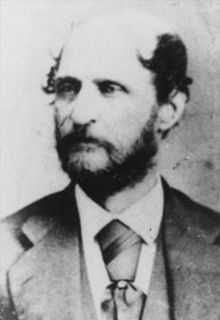Birkett D. Fry
| Birkett Davenport Fry | |
|---|---|
 | |
| Born |
June 24, 1822 Kanawha County, West Virginia |
| Died |
January 21, 1891 (aged 68) Richmond, Virginia |
| Place of burial |
Oakwood Cemetery Montgomery, Alabama |
| Allegiance |
|
| Service/branch |
|
| Years of service | 1861–65 |
| Rank |
|
| Battles/wars |
American Civil War - Peninsula Campaign - Battle of Seven Pines - Battle of Antietam - Battle of Chancellorsville - Battle of Gettysburg - Siege of Petersburg - Battle of Meadow Bridge |
Birkett Davenport Fry (June 24, 1822 – January 21, 1891) was an adventurer, soldier, lawyer, cotton manufacturer, and a Confederate general in the American Civil War. A survivor of four battle wounds, he commanded one of the lead brigades during Pickett's Charge at the Battle of Gettysburg.
Early life
Fry was born in Kanawha County, Virginia (now West Virginia). He received his education at Virginia Military Institute in Lexington, and attended the United States Military Academy, but did not graduate with the Class of 1846, having failed mathematics and being subsequently dismissed. He then returned to his native Virginia to study law. He resumed his interest in the military with the outbreak of the Mexican-American War, serving as a first lieutenant of voltigeurs.
Following the war, as with so many other adventurers, Fry moved to California as a "Forty-Niner." Fry hung out his shingle as a practicing lawyer in Sacramento City and was elected Justice of the Peace, Fourth Ward in 1852. In October 1856, he accompanied the filibusterer, William Walker, during his expedition to Nicaragua as a colonel (and later general) in Walker's mercenary army. Fry returned to California, living there until 1859 when he moved to Alabama and engaged in cotton manufacturing.[1] Fry had married Martha MiCou, whose family were among the owners of the cotton mills in Tallassee, Alabama.[2]
Civil War
With Alabama's secession from the Union, Fry enlisted in the Confederate army and was appointed Colonel of the 13th Alabama Infantry. The regiment was transported to Virginia and fought in the Peninsula Campaign. Colonel Fry was wounded in action at the Battle of Seven Pines. He recovered in time to command his regiment in the savage fighting at Antietam, where he was again wounded, suffering a shattered arm.
Fry rejoined his regiment and led it during the 1863 Battle of Chancellorsville, where he suffered a third wound. During the subsequent Gettysburg Campaign, Fry's regiment was among the first Confederate units to deploy into battleline and engage the Union cavalry of John Buford at the opening of the Battle of Gettysburg on July 1, 1863. His men suffered considerable casualties as the day progressed after being driven off McPherson's Ridge by the arrival of the Federal Iron Brigade. With the capture of Brig. Gen. James J. Archer, Fry assumed command of Archer's Brigade of Tennesseans and Alabamans. Held in reserve on July 2, Fry's brigade was a key part of the July 3 attack that became famous as Pickett's Charge. He suffered yet another wound, and fell near the Union lines. Held as a prisoner of war at Fort McHenry in Baltimore, Fry was treated in a local field hospital.
There, rumors circulated that Fry had been involved in the August 1862 murder of Union general Robert L. McCook in Alabama. Fry's West Point classmate, John Gibbon, who ironically commanded the troops that had shot Fry at Gettysburg, vouched for his character and the matter was forgotten.[3]
Exchanged in 1864, Fry rejoined the Army of Northern Virginia in time for the beginning of the Siege of Petersburg. During Philip H. Sheridan's raid on Richmond in early May, Fry was assigned command of Seth Barton's Virginia brigade, leading it during the Battle of Meadow Bridge. He was promoted to brigadier general on May 24, 1864.
During the final months of the war, Fry was placed in command of a military district in South Carolina and Georgia.
Postbellum
After surrendering in Augusta, Fry emigrated to Cuba at the close of hostilities, lodging in Havana hotels with several other former prominent Confederates, including Jubal A. Early, John C. Breckinridge, Robert A. Toombs, and John B. Magruder, among others.[4] He did not return to the United States until 1868, when he returned to Tallassee, Alabama as a businessman. He resided at No. 1, King Street, in a house built for Confederate Officers in charge of the Tallassee Armory.[5] His home is still standing and after renovations now serves as the law offices of The Segrest Law Firm. Fry later expanded his business career in Florida, and, in 1881, moved to Richmond, Virginia, where he was president of a cotton mill for a decade.
Fry died in Richmond and was buried in Oakwood Cemetery in Montgomery, Alabama.
See also
- List of American Civil War generals
Notes
References
- Hess, Earl J., Pickett's Charge: The Last Attack at Gettysburg, Chapel Hill: University of North Carolina Press, 2001. ISBN 0-8078-2648-0.
- Pérez, Louis A., Jr., Cuba and the United States: Ties of Singular Intimacy, Athens: University of Georgia Press, 2003. ISBN 0-8203-2483-3.
- Warner, Ezra J., Generals in Gray: Lives of the Confederate Commanders, Baton Rouge: Louisiana State University Press, 1959. ISBN 0-8071-0823-5.
- Golden, Virginia Noble, A History of Tallassee, Tallassee Mills of Mount Vernon-Woodberry Mills, 1949, LC Control No.: 50034427.